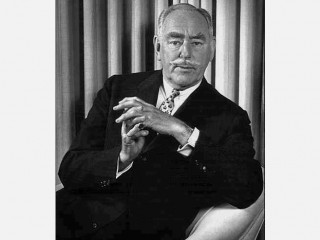
Dean Acheson biography
Date of birth : 1893-04-11
Date of death : 1971-10-12
Birthplace : Middletown, Connecticut, U.S.
Nationality : American
Category : Politics
Last modified : 2011-02-18
Credited as : Lawyer and statesman, U.S. secretary of state,
The American lawyer and statesman Dean Gooderham Acheson served as secretary of state in President Harry Truman's Cabinet.
Dean Acheson was born in Middletown, Conn., on April 11, 1893, the son of Edward Campion and Eleanor Gooderham Acheson. His father, the Episcopal bishop of Connecticut, provided a genteel upbringing which led to Groton and afterward Yale, where Acheson received his bachelor's degree in 1915. During the succeeding 3 years he served briefly as an ensign in the U.S. Navy and earned his law degree at Harvard. In May 1917 he married Alice Stanley. Three children were born to the Achesons—Jane, David Campion, and Mary Eleanor.
From the beginning Acheson seemed destined for a successful career. Possessed of high intelligence, a deep sense of moral rectitude, and aggressive energy, he had in addition the grace of the patrician and the friendship of such distinguished and influential people as Felix Frankfurter of the Harvard Law School and, later, the Supreme Court of the United States.
Following his graduation from Harvard, Acheson became private secretary to Supreme Court justice Louis D. Brandeis. In 1921 he entered the prominent Washington law firm of Covington, Burling, and Rublee, where he practiced for the next 12 years. President Franklin D. Roosevelt first brought Acheson into public service in May 1933 with an appointment as undersecretary of the Treasury. Acheson resigned 5 months later following a disagreement on the President's gold-purchasing program and returned to his Washington law practice.
In 1941 Acheson again entered the government, this time as assistant secretary of state for economic affairs. He remained in the State Department, except for one brief interlude, until 1953. His long and significant record there reflected a practical rather than a contemplative mentality, which attracted him especially to Harry Truman's forthright leadership. As undersecretary of state from 1945 to 1947, Acheson broke with Truman only on the Palestinian question, convinced that the nation was embarking on a unilateral commitment to Israel's defense against the Arab states which could ultimately prove embarrassing, if not costly.
Acheson's most memorable contributions, as undersecretary and, from 1949 to 1953, as secretary of state, came in his implementation of the containment policy from the Marshall Plan to NATO. Despite his achievements, these years in the State Department were trying ones. The alleged loss of China to Communist leadership in 1949 exposed the Truman administration to charges of treason. Acheson, always loyal to his friends and associates, refused to testify against Alger Hiss, then under trial for spying, or to condemn past American policy toward China. These actions rendered him totally vulnerable and roused a storm of accusations such as few commanding public figures in American history have faced.
Upon his retirement from the State Department in 1953, Acheson returned to Covington and Burling, remaining in public life only as a member of special governmental committees, as a presidential adviser, and as a critical observer of men and events. He served in the late fifties as foreign policy chief of the Democratic Advisory Council of the Democratic National Committee. He died in Sandy Spring, Md., on Oct. 12, 1971.
Acheson's own writings are voluminous. Three of his books which develop his views of external policy, politics, and government are A Democrat Looks at His Party (1955), A Citizen Looks at Congress (1957), and Power and Diplomacy (1958). His autobiography, Morning and Noon (1965), terminates with his appointment to the State Department in 1941. Acheson's personal record of his State Department experience is Present at the Creation: My Years in the State Department (1969).
No book-length biographies of Acheson have yet appeared. McGeorge Bundy, ed., The Pattern of Responsibility (1952), includes excerpts and paraphrases of Acheson's many speeches during his secretarial years and is a good source of information on his views toward world affairs. The volumes covering the years 1949 to 1952 of The United States in World Affairs (1950-1953), prepared by Richard P. Stebbins for the Council on Foreign Relations, are replete with observations on Acheson's leadership. Also useful is the survey of postwar American foreign policy, William Reitzel and others, United States Foreign Policy, 1945-1955 (1956). Acheson's role as an adviser to Kennedy is discussed in Seyom Brown, The Faces of Power (1968).
















